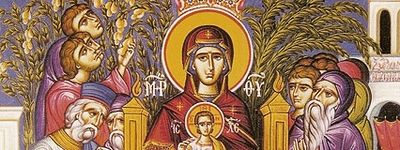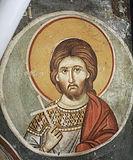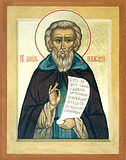

| Previous day | Next day |
| Old Style
April 7
|
Saturday |
New Style
April 20
|
|
5th Week of Great Lent. Laudation of the Most Holy Theotokos. The Akathist of the Most Holy Theotokos.
Tone 4.
Great Lent. |
Wine and oil allowed.
|
![]() St. George the Confessor, bishop of Mytilene (820).
St. George the Confessor, bishop of Mytilene (820).
Martyr Calliopus, at Pompeiopolis in Cilicia (304). Hieromartyr Rufinus, deacon, and Martyrs Aquilina and 200 soldiers, at Sinope (ca. 310). St. Daniel of Pereyaslavl, founder of St. Daniel Monastery (1540). St. Serapion the Sindonite, monk, of Egypt (V). Uncovering of the relics of St. Serapion, archbishop of Novgorod (1517). St. Gabriel, archbishop of Ryazan and Zaraisk (1862).
New Hieromartyr Arcadius Dobronravov, archpriest, of Tsivilsk (Chuvashia) (1933).
Icon of the Theotokos: “I Am with You, and No One Is against You.”
St. Hegesippus the Chronicler, of Palestine (ca. 180). Venerable Brynach of Wales (6th c.). St. George, patriarch of Jerusalem (807). St. Gerasimus, hieromonk, of Patmos (1739).
Repose of Schemamonk Theodore of Svir (1822) and Schemamonk Agapitus the Blind, of Valaam (1905).
Thoughts for Each Day of the Year
According to the Daily Church Readings from the Word of God
By St. Theophan the Recluse

Saturday. [Heb. 9: 24–28; Mark 8: 27–31]
The Lord asked the apostles how they see Him? In the person of the holy Apostle Peter, they answered Thou art the Christ. This confession did not ripen suddenly, but once it ripened, it settled in the depths of the heart and became the source of his guidance. It was overshadowed by the death of the Lord, but not shaken, and being resurrected in even greater power by the resurrection, it directed the apostles for their entire lives to preach to the whole world. There is a moment for each believer, when he utters with all his strength, “Thou art the Christ, my Lord and Saviour. Thou art my salvation, my light, my strength, my comfort, my hope and eternal life.” Then is accomplished that by which this believer cries with the Apostle: “Who shall separate me from the love of Christ!” (cf. Rom. 8:35) and like him he begins to pursue all that is pleasing to Christ the Lord until he comes unto the measure of His stature (cf. Eph. 4:13).
Articles
 St. George the Confessor the Bishop of MytileneSaint George, Metropolitan of Mytilene, from his youth he led a monastic life, and was especially accomplished in the virtue of humility. |
 Venerable Daniel the Abbot of Pereslavl-ZalesskySaint Daniel of Pereslavl (in the world Demetrius) was born around 1460 in the city of Pereslavl-Zalessky. |
 Venerable Serapion of EgyptSaint Serapion lived during the fifth century in Egypt. He was called the linen cloth-wearer (Sindonite) since he wore only a coarse linen garb called a “sindon.” |
 Laudation of the Mother of God |




